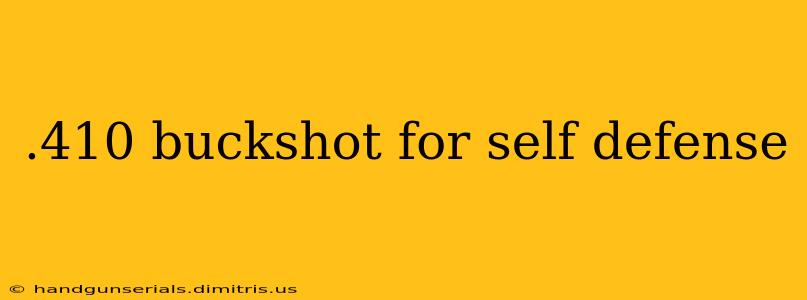The .410 bore shotgun, often overlooked in self-defense discussions, presents a unique set of considerations. While not as popular as 12-gauge or 20-gauge shotguns, the .410's compact size and manageable recoil make it attractive to some. However, its effectiveness in self-defense, particularly when using buckshot, requires careful examination. This guide will delve into the pros and cons, exploring its suitability for home protection and personal safety.
Understanding .410 Buckshot
Unlike larger shotgun gauges, the .410 bore fires a smaller payload. This means fewer pellets per shell, typically ranging from three to nine depending on the manufacturer and shell type. These pellets are generally smaller than those found in larger gauges, impacting their stopping power and effective range. While .410 buckshot offers a decent spread at close range, its effectiveness diminishes rapidly with distance.
Advantages of .410 Buckshot for Self-Defense:
- Compact Size and Maneuverability: The .410's smaller size allows for easier handling and storage, making it suitable for individuals with limited upper body strength or those needing a more compact home defense weapon. It's easily maneuverable in tight spaces.
- Reduced Recoil: Lower recoil is a significant advantage, especially for less experienced shooters or individuals sensitive to recoil. This allows for faster follow-up shots, crucial in a self-defense situation.
- Quieter than Larger Gauges: The smaller bore generally produces a less intense report, potentially minimizing hearing damage and alarming neighbors. This is important for situations where discretion is paramount.
Disadvantages of .410 Buckshot for Self-Defense:
- Limited Stopping Power: The smaller number and size of pellets in .410 buckshot compared to larger gauges significantly reduces its stopping power. This translates to a lower probability of instantly incapacitating an attacker. Overpenetration is also a concern, depending on the ammunition used.
- Shorter Effective Range: The smaller pellets lose velocity more quickly, resulting in a much shorter effective range than larger gauges. Accurate shots beyond 15-20 yards become significantly more challenging.
- Ammunition Availability and Cost: While .410 ammunition is readily available, the selection might be more limited than for 12-gauge or 20-gauge shotguns, particularly regarding premium defensive ammunition. The price per round can also be comparatively higher.
Alternative Self-Defense Options
Before settling on a .410 for self-defense, consider other options offering potentially better stopping power and effective range, such as:
- 12-Gauge Shotgun: The most common choice for home defense, offering significant stopping power and a wide range of ammunition options.
- 20-Gauge Shotgun: A good compromise between stopping power and manageable recoil, providing a more manageable option compared to the 12-gauge.
- Handguns: Pistols and revolvers offer portability and ease of use but require more precise shot placement for effective self-defense.
Conclusion: Is .410 Buckshot Right for You?
The .410 bore, while manageable and relatively quiet, presents compromises in stopping power and effective range when compared to larger shotgun gauges. Its suitability for self-defense depends heavily on individual circumstances, training, and proficiency. While it might be adequate for close-quarters encounters within a home, its limitations should be thoroughly understood. Choosing a self-defense firearm requires careful consideration of your individual needs and abilities, and consulting with firearms experts and law enforcement is highly recommended. Always prioritize proper training and safe handling practices. This information is for educational purposes only and does not constitute legal or firearms advice. Consult relevant laws and regulations in your jurisdiction.

